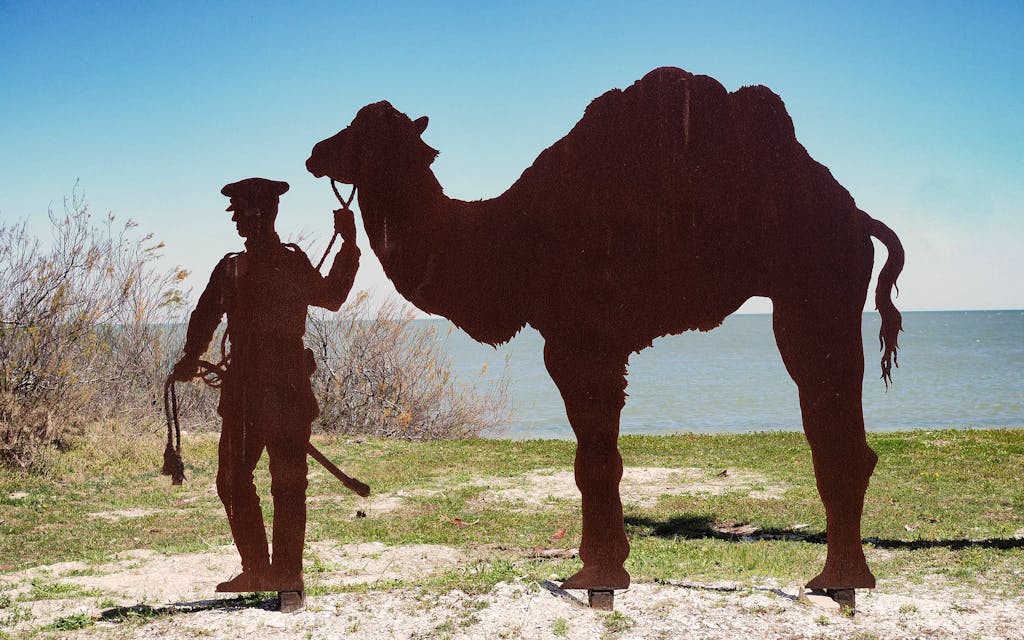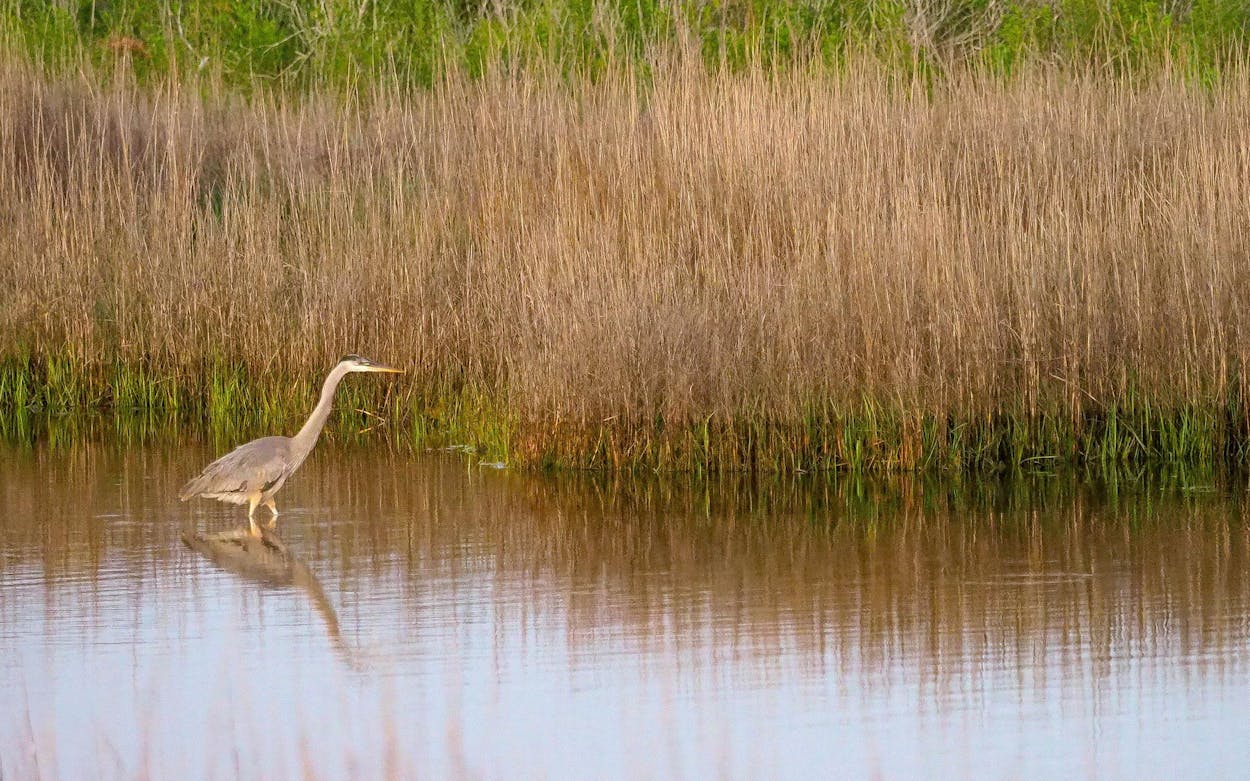While driving along the Texas coast two summers ago, I stumbled into a faded bar and restaurant at the Indianola Fishing Marina. The bustling waterside business surprised me. From what I recalled of Texas history, two successive hurricanes in the late 1800s had permanently erased Indianola, which is perched on Matagorda Bay, fifteen miles southeast of Port Lavaca. But there I sat, at a picnic table overlooking Powderhorn Lake as the sun set, tossing back a cheeseburger, fries, and a beer as a band cranked out cover tunes and someone sold bait from a counter inside. I’ve been wanting to return ever since. I finally made it back to Indianola this spring, and spent two peaceful days learning about the region’s history, camping on the beach, and meeting friendly locals. There is, admittedly, very little to do here, but that’s precisely the appeal.
Before you drive down Texas Highway 316 to Indianola, make sure to stop at the Calhoun County Museum in nearby Port Lavaca for a history primer. Housed in an old library, the museum may not look like much from the outside, but it’s teeming with centuries-old artifacts that shed light on the rich and little-known history of this region. Browse spear points, fishing hooks, and other tools that were vital to the early Karankawa people, who survived on shellfish from the coastal waters in the winter and moved inland to hunt buffalo and deer during warmer months. René-Robert Cavelier, a French gentleman explorer who was known as Sieur de La Salle, mistakenly came ashore in 1685 while trying to reach the mouth of the Mississippi River. His time in Texas didn’t go well: one of his ships was stolen by pirates, a second was lost at sea, and a third sailed home to Europe, full of colonists who’d changed their minds. Cavalier’s fourth and last ship, the Belle, sank in Matagorda Bay after a storm. Its hull is now on display at the Bob Bullock Texas State History Museum in Austin. You can see a few items from it at the Calhoun County Museum, including a cannonball; trade goods like rings, beads, and buttons; and pieces of a leather shoe.
In 1842, a German group called the Adelsverein organized specifically to send immigrants to Texas. Its first arrivals landed on a stretch of beach not far from the marina where I ate that cheeseburger. Ultimately, more than 100,000 immigrants arrived in what was dubbed Karlshafen from 1844 to 1887, according to Vicki Cox, a longtime attendant at the Calhoun County Museum. Many moved inland to settle in New Braunfels and Fredericksburg. The community of Indian Point was founded less than a mile away from Karlshafen in 1846, and it soon became an established deepwater port. Eventually the two towns merged and became known as Indianola (ola means “wave” in Spanish). Wharves went up, steamships brought in goods, and the U.S. Army even delivered camels to use as pack animals as settlers pushed westward. Angelina Eberly, the innkeeper who had famously fired a cannon at rangers attempting to move the state archives from Austin to Washington-on-the-Brazos in 1842, opened a hotel. “It was quite a booming little town for several years,” says Cox. At its peak in 1875, Indianola was the second-busiest port in Texas, home to five thousand people and no fewer than four newspapers. But two hurricanes, one in 1875 and another in 1886, delivered a fatal one-two blow. Indianola had become a ghost town by 1887, and many of its surviving homes were moved to Cuero and Victoria.
Today, only a few fishing cabins stand in what remains of Indianola, but you’ll still find a few relaxing things to do. Hang out at the marina, fish or bird-watch in the bay, rent a kayak, or simply relax on the 1.5-mile strip of sand that fronts Matagorda Bay, at one of the last free public beaches in the state. “It’s the salt water; it’s the beach; it’s the air,” Calhoun County commissioner David Hall explains at a picnic table at the Indianola Fishing Marina, as he and his fiancée, Amanda Massey, a first-grade teacher in Port Lavaca, nibble fried pickles. “It’s kind of an enchanting place.” Nature lovers can rest assured that the area’s pristine marshes will stay that way. In one of the biggest deals in state conservation history, the Texas Parks and Wildlife Foundation bought the 17,000-acre Powderhorn Ranch just across the lake in 2014; in about a decade, 2,000 of those acres will open to the public as a state park.

A walking tour of the town reveals subtle signs of its bustling past. You can admire a towering granite monument dedicated to La Salle, put your hand on a huge chunk of granite that marks the location of a long-gone courthouse, see a metal cutout representing the military camels that came through the port, visit a cemetery where early residents are buried, or peer into an old cistern that provided water to residents of Karlshafen. Hale says locals have found arrowheads and Civil War–era musket balls in the area.
The only business in town is the marina, which has operated under various owners for several decades. (Various entrepreneurs have sold bait here for about a century.) Garon and Tami Applegate, who bought an old school bus and converted it into a rolling home before striking out from Idaho last November, are sipping beers and watching for dolphins a few tables down from mine. “We just wandered around and found this little gem,” Tami says. They’ve been here two weeks and have befriended the marina staff. “It’s just so peaceful.”
The marina’s current owners are Zachary Myers and Everett Lorenz, who bought the place last year. Both men live in Bastrop County but know of Indianola because they love to fish. “These bays are world-class fishing,” Myers says. “When you go to Port Aransas or Galveston, there are touristy shops and all that kind of mess. When you go to Indianola, you are going there to go fishing, trust me, because there’s nothing else to do.” He and Lorenz have added a full bar and new furnishings, and they’re preparing to rebuild the on-site RV park. You can rent a kayak for $10 an hour, launch a boat for a fee, buy bait, buy a T-shirt, or catch live music on weekends. The food is typical beach fare: fried shrimp, crab cakes, cheeseburgers, fish tacos, and redfish. For the freshest option, bring in your own catch and let the chef cook it up for $12.99 per person, a deal that includes fries, hush puppies, and a side salad. “I’m a sucker for tacos, and in the morning, we make what we call trash-can tacos with anything and everything we can throw in there,” Myers says.
There are no hotels in Indianola. Boondocking, or parking for free on public land, is the way to go, and Indianola Beach Park is one of the few sandy spots in Texas where you can still camp for free. After making the rounds, I pull my silver camper van, which I’ve named Vincent VanGo, onto a patch of coarse sand next to Matagorda Bay, within walking distance of an aging but clean restroom. Across the street, a wooden boardwalk leads out over a marsh. I have to step over the desiccated remains of a three-foot-long dead alligator on the side of the road to get there, but the walkway makes a great spot to observe bird life at sunset. Herons, egrets, ducks, gulls, and an eye-popping pair of Pepto-Bismol-colored roseate spoonbills pass by. I listen to the waves crash all night, and in the morning, I wiggle my toes in the cool sand as I sip hot tea and contemplate. A barge passes in the distance, and a few pelicans flap overhead. Indianola may not have much, but it’s got everything I need.
- More About:
- Port Lavaca






